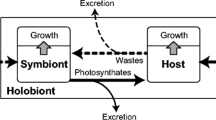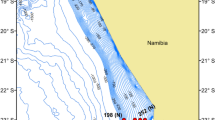Abstract
Invertebrates containing endosymbiotic dinoflagellate algae (zooxanthellae) retain excretory nitrogen, and many are able to take up ammonium from the surrounding seawater. However, the site of assimilation and role of nitrogen recycling between symbiont and host remains unclear. In the present study, ammonium uptake by the symbiotic sea anemone Anemonia viridis (Forskål) was examined by following the pathway of assimilation using 15N-enriched ammonium. Since zooxanthellae became enriched with 15N from ammonium at up to 17 times the rate of the host, they appear to be the primary site of assimilation. In the light, the rate of zooxanthellae enrichment at 20 M was twice that at 10 M, whereas the rate of host enrichment was not significantly affected by ammonium concentration. When anemones were incubated with [15N]ammonium in the dark, after 12 h without light the rate of enrichment was lowered in both zooxanthellae and host. However, while the enrichment of the host was significantly reduced when the light level was lowered from 300 to 150 μmol photons m−2 s−1, zooxanthellae enrichment was unchanged. Low molecular weight material from the zooxanthellae became enriched at 20 times the rate of that from the host, and enrichment was detected in the amino acids glutamate, glutamine, aspartate, alanine, glycine, phenylalanine, threonine, valine, tyrosine, and leucine from zooxanthellae. In the zooxanthellae, amino acids accounted for 65% of the total enrichment of low molecular weight material. Of the amino acids detected in zooxanthellae, over 90% of the enrichment was accounted for by glutamate, glutamine and aspartate. The enrichment of the amide group of glutamine was greater than that of the amine group of glutamate or glutamine, consistent with the glutamine synthetase/glutamine 2-oxoglutarate amidotransferase cycle as the mechanism of ammonium assimilation. To examine the flux of 15N from zooxanthellae to host, anemones were pulse-labelled with [15N]ammonium and then transferred to an unlabelled chase. Over a 2 h period there was no evidence for a flux of nitrogen from zooxanthellae to host. However, during the chase period, the enrichment of low molecular weight material declined and that of high molecular weight material increased in both zooxanthellae and host, indicating that protein was synthesized using 15N from ammonium in both components of the symbiosis. Again by using a pulse-chase system, it was found that glutamate was metabolised most rapidly by zooxanthellae, followed by (in order of decreasing rate of turnover) aspartate, alanine, glycine and valine (no data are available for glutamine). Unlike these amino acids, nitrogen was transferred to the essential amino acids phenylalanine and threonine, increasing their enrichment during the chase period. While recycled nitrogen is clearly important to this symbiosis, the mechanism by which it is cycled remains to be resolved.
Similar content being viewed by others
Author information
Authors and Affiliations
Additional information
Received: 23 November 1998 / Accepted: 25 May 1999
Rights and permissions
About this article
Cite this article
Roberts, J., Davies, P., Fixter, L. et al. Primary site and initial products of ammonium assimilation in the symbiotic sea anemone Anemonia viridis. Marine Biology 135, 223–236 (1999). https://doi.org/10.1007/s002270050620
Issue Date:
DOI: https://doi.org/10.1007/s002270050620




